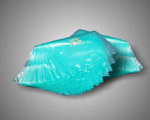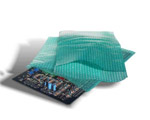|
The perfect world of ESD safe packaging
In case you are designing the ESD safe packaging for a component or an assembly, here are some useful hints:
- Put an antistatic, non tribocharging, highly electrically resistent material in intimate touch with the components (i.e. antistatic bag, antistatic foam etc)
- If possible, do not use conductive materials in intimate touch with the parts. This is because
- - the conductive materials cause a too fast short-circuiting of the components
(sparking danger)
- - the conductive materials will not isolate the content of the packaging from their own
charge (if for example, I am charged and I touch a conductive bag, the charge is
immediately communicated to the parts inside)
- - the conductive materials are normally carbon loaded, therefore they may release
higly conductive particles on the assemblies, which is really not good
- - if there are powered components, they should be isolated
- use a highly conductive material for the proximity packaging, in order to create a Faraday Cage surrounding the components. Remember that, in order to operate, a shielding packaging should be closed all around the parts (no open boxes or bags).
- Trays or racks, which are open packagings, are only grounding means for the components, but will not protect the parts from outer fields, and therefore are not designed to protect the components outside the E.P.A. by themselves. Trays or racks are diesigned to be inserted into conductive boxes or shielding bags, to go out of the E.P.A.
- Antistatic (i.e. pink poly or so) packaging are not providing any shielding on the components, therefore they cannot be used as the only ESD protection outside the E.P.A.
- The more the proximity layer is conductive and the better isolation it provides to the parts inside the packaging. But a good shielding is also provided by the thickness of the packaging (for example, a conductive box, lined with antistatic foam, usually provides a better protection than a highlly conductive shielding bag, and this happens because there is a direct physical contact between the bag surface and the components – the charged conductive layer is separated only by a few microns of antistatic polyethilene from the assemblies). Instead the boxes usually provide some millimeters or centimeters between the external charges and the inside.
- Remember to put ESD warning signs when the ESD packaging starts, in a way that operators will exactly know when the ESD packaging starts, at the moment of opening a delivered box. Also, it is very important to know in advance that inside a packaging there are parts sensitive to electrostatic shocks
- The outer layer of the ESD packaging has always to be antistatic and no-sparking generator
This and othere arguments are of major importance when designing a good packaging for ESD sensitive parts. Please ask if more informations are needed.
|




